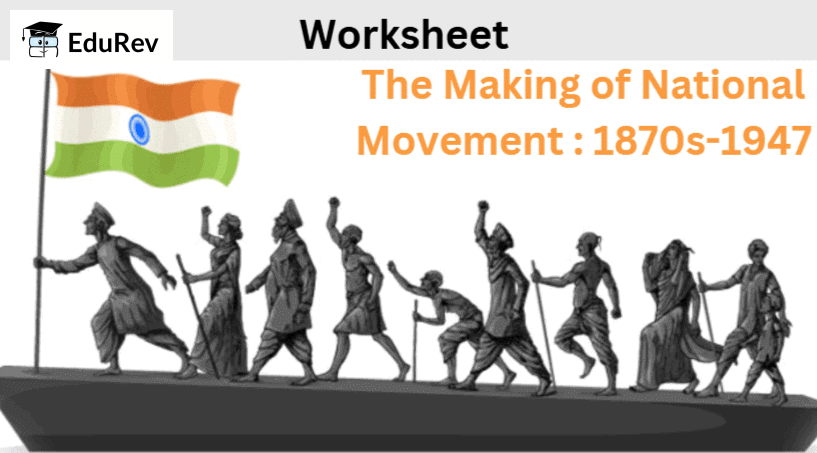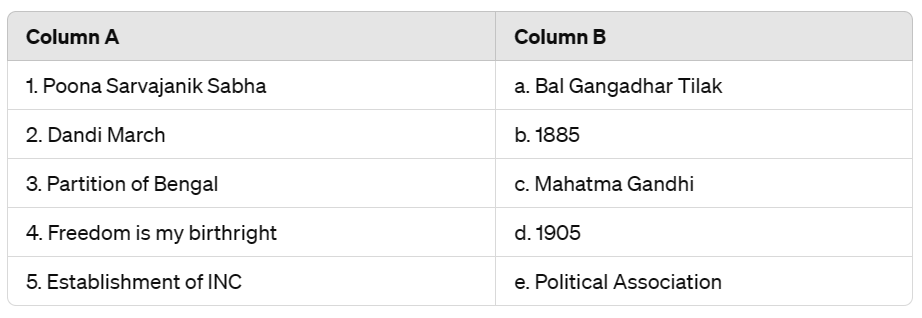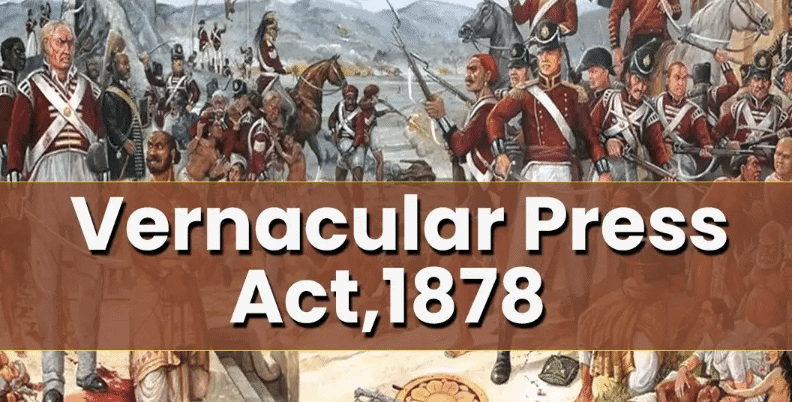The Making of National Movement : 1870s-1947 Class 8 Worksheet History Chapter 8
| Table of contents |

|
| Multiple Choice Questions (MCQs) |

|
| Fill in the Blanks |

|
| Match the Columns |

|
| True/False |

|
| Very Short Answer Questions |

|
| Short Answer Questions |

|

Multiple Choice Questions (MCQs)
Q1: Which political association was not formed in the 1870s or 1880s?
a) Poona Sarvajanik Sabha
b) Indian Association
c) Madras Mahajan Sabha
d) All India Muslim League
Q2: What was the primary aim of the early Indian National Congress?
a) Immediate independence from British rule
b) Greater representation for Indians in government
c) Establishment of a separate Muslim state
d) Formation of an Indian army
Q3: Which three leaders were collectively known as 'Lal, Bal, Pal'?
a) Tilak, Gokhale, Tagore
b) Tilak, Pal, Rai
c) Naoroji, Mehta, Banerji
d) Gandhi, Nehru, Patel
Q4: In which year was the Indian National Congress established?
a) 1885
b) 1905
c) 1915
d) 1947
Q5: The Rowlatt Act of 1919 led to which significant event?
a) Partition of Bengal
b) Jallianwala Bagh massacre
c) Formation of the Muslim League
d) Dandi March
Fill in the Blanks
Q1: The ______ allowed the British government to confiscate the assets of newspapers that published 'objectionable' content.
Q2: _______ was the leader who declared, "Freedom is my birthright, and I shall have it!"
Q3: The _______ Act of 1919 allowed the British government to arrest any person without a warrant.
Q4: The partition of _______ in 1905 by Viceroy Curzon caused widespread anger and led to the Swadeshi movement.
Q5: The treaty imposed on the Turkish Sultan in 1920 led to the _______ Movement.
Match the Columns

True/False
Q1: The Vernacular Press Act was introduced to promote freedom of the press in India.

Q2: The Indian National Congress was divided into extremists and moderates in 1907.
Q3: The Ilbert Bill sought to prevent Indian judges from trying British individuals.
Q4: The Lucknow Pact was an agreement between the Indian National Congress and the British government.
Q5: The Chauri Chaura incident led to the continuation of the Non-Cooperation Movement.
Very Short Answer Questions
Q1: Name the newspaper edited by Balgangadhar Tilak.
Q2: When was the Muslim League formed?
Q3: When did the Congress split and reunite?
Q4: What was the Swadeshi Movement known as in deltaic Andhra?
Q5: Who were the leaders of the Khilafat agitation?
Short Answer Questions
Q1: What was the purpose of the Ilbert Bill introduced in 1883?
Q2: Why was the Vernacular Press Act significant?
Q3: What was the impact of the Arms Act of 1878 on the Indian population?
Q4: Explain the significance of the Lucknow Pact of 1916.
Q5: What was the Khilafat Movement, and how was it connected to the Non-Cooperation Movement?
You can access the solutions to this worksheet here.
|
69 videos|431 docs|46 tests
|
















